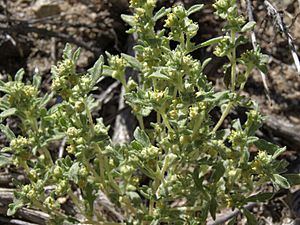Euphrosyne nevadensis facts for kids
Quick facts for kids Euphrosyne nevadensis |
|
|---|---|
 |
|
| Scientific classification | |
| Synonyms | |
|
Euphrosyne nevadensis is a type of plant that belongs to the Asteraceae family, which is also known as the daisy or sunflower family. This plant is native to the western parts of the United States. You can find it growing naturally in Nevada and in eastern California, specifically in Inyo and Mono Counties.
Contents
What is Euphrosyne Nevadensis?
This plant is often called by its scientific name, Euphrosyne nevadensis. It was once known by other names like Chorisiva nevadensis or Iva nevadensis. Scientists sometimes change plant names as they learn more about them. It's a small plant that grows in dry, open areas.
Where Does It Grow?
Euphrosyne nevadensis loves sunny, dry places. It is found in the Great Basin region of the western United States. This area has a lot of deserts and mountains. The plant is well-suited to living in these tough conditions. It can grow in sandy or rocky soils.
Its Habitat
The plant's natural home includes parts of Nevada and California. These areas often have hot summers and cold winters. The plant has adapted to survive with little water. It's an important part of the local plant communities in these regions.
Plant Appearance
Like other plants in the daisy family, Euphrosyne nevadensis has small flowers. These flowers usually grow in clusters. The plant itself is often small and bushy. Its leaves might be narrow or lobed. This helps the plant save water in dry environments.
Flowers and Seeds
The flowers of Euphrosyne nevadensis are usually not very showy. They are often yellowish or greenish. After the flowers bloom, they produce seeds. These seeds help the plant reproduce and spread to new areas. The seeds are often carried by wind or animals.
Life Cycle
Euphrosyne nevadensis is an annual plant. This means it completes its entire life cycle in one growing season. It sprouts from a seed, grows, flowers, produces new seeds, and then dies. The new seeds will then sprout the next year. This cycle helps it survive in places with changing seasons.
Reproduction
The plant reproduces using its seeds. When the conditions are right, the seeds will germinate. This means they will start to grow into new plants. The plant's flowers are important for making these seeds. They are pollinated by insects, which helps the plant create new seeds.
See also
 In Spanish: Chorisiva para niños
In Spanish: Chorisiva para niños

